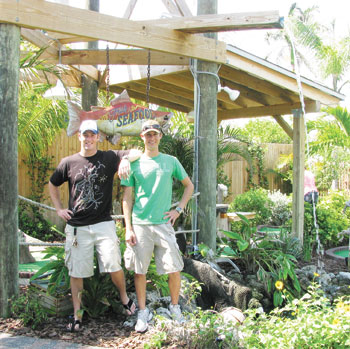Catch some fun at The Fish Hole

SUN PHOTO/LOUISE BOLGER
Dana Snell and Jake Spooner
offer affordable family entertainment.
I’ve heard it said a lot during the years I’ve lived in Florida those who fish don’t golf and vice versa. Well there’s a place in Bradenton Beach where you can take that theory and literally putt it out of the water. The Fish Hole on Bridge Street goes way beyond traditional miniature golf calling itself adventure golf with a little local history and fishing education mixed in.
For years, visiting families who shopped at Jake Spooner and Dana Snell’s two Island shops, Island Bazaar in Holmes Beach and Bridge Street Bazaar in Bradenton Beach asked, “What is there to do on the Island after the beach?” They now have an answer to that question. The Fish Hole Adventure Golf opened in April of last year, providing a place for affordable family activity.
Spooner and Snell hired Anna Maria architect Mike McCaleb to design The Fish Hole, and if there was a prize for creative, cute and just plain fun, he would win it hands down. The concept was to bring an old Florida fishing village feel to the golf course by incorporating historic reproductions and fish facts.
The ice house and water tower, complete with running water are based on actual buildings which once existed in the historic Cortez fishing village, and the old wooden bridge represents the original bridge from Cortez to Anna Maria. They are continually gathering historical information about Anna Maria and Cortez to be placed around the beautifully landscaped grounds.
Each of the 18 holes is named after a different fish – the black tip shark, the grouper, the barracuda and the tarpon are some examples. But what makes the 18 holes even more interesting is the degree of difficulty of a particular hole is directly tied to the degree of difficulty in catching the fish the hole is named for. A lesson in fishing and golf rolled into one. At night, The Fish Hole’s park-like setting become even more magical when the "village" twinkles.
A round of golf is only $7.50 per person for both adults and kids, and there are $1 off coupons available. They have clubs for all heights from children to tall adults, and if you need a break, you can rest in one of their colorful rocking chairs. They also have party packages that are great for birthday celebrations and family get togethers.
In October, Spooner and Snell sponsored their first golf tournament at The Fish Hole as part of the Bridging The Gap festivities and plan on making it an annual event. They want to thank everyone who visited The Fish Hole this year for helping them to have a very successful first year.
I guess if you’ve been friends since you’re six years old, like Jake Spooner and Dana Snell, you never really lose that childlike ability to have fun. What they’ve created at The Fish Hole is affordable family entertainment wrapped up in lot of old Florida charm. Like they say at The Fish Hole, you’ll "Git Hooked." Who says fishing and golf don’t mix?
The Fish Hole
115 Bridge StreetBradenton Beach
941-778-3400
9 a.m. to 9 p.m. daily


